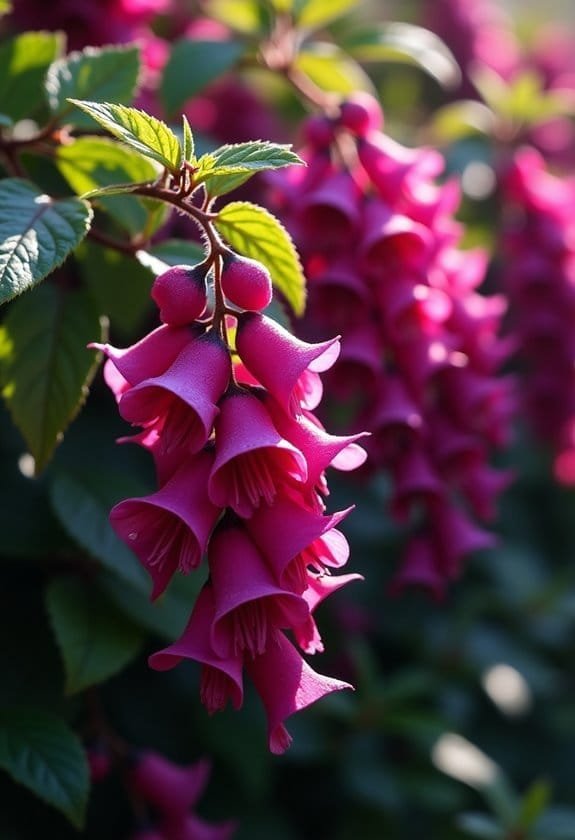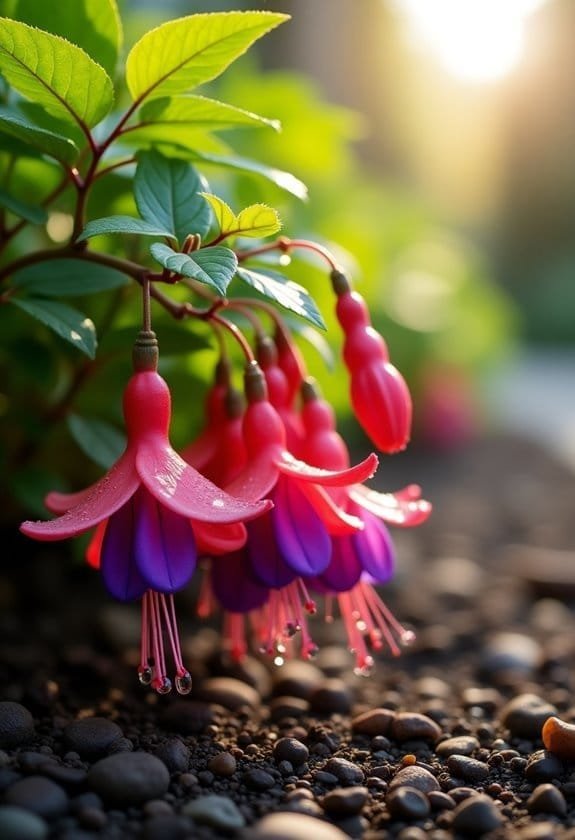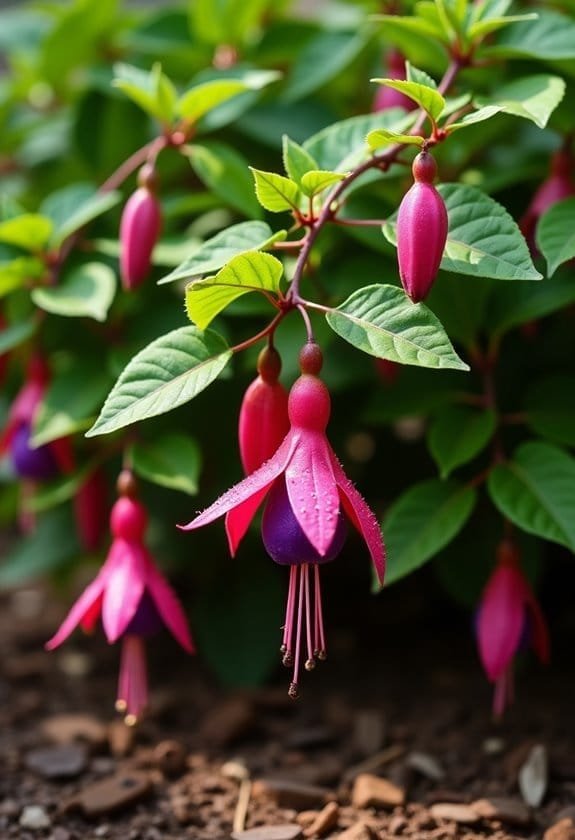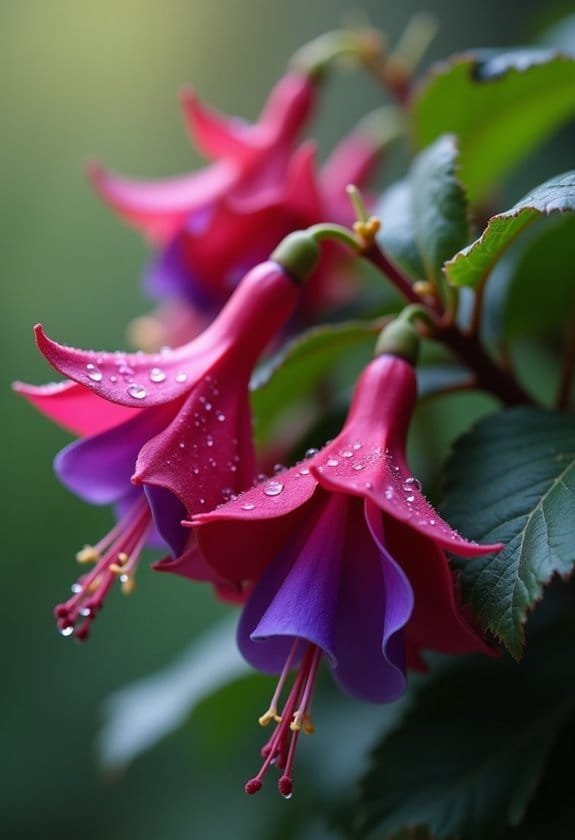Fuchsia species, particularly the hardy types of the Onagraceae family, flourish in temperate gardens due to their striking, bi-colored blooms and adaptability. These plants typically reach heights of 1 to 5 feet, thriving in USDA Zones 6-10 with well-drained soil and ample sunlight. They flower from late spring through frost, attracting beneficial pollinators, including bees and hummingbirds. Regular care, such as watering and strategic pruning, promotes vigor, while awareness of pests and diseases guarantees health. The allure of their edible fruit further enriches the gardening experience, encouraging biodiversity. Discovering the myriad of varieties available can enhance any landscape beautifully.
Main Points
- Fuchsia magellanica is a prominent hardy species, adaptable to USDA Zones 6-10, known for its vibrant and unique blooms.
- Hardy fuchsias thrive in moist, well-drained soil with at least six hours of sunlight daily, ensuring optimal growth and flourishing flowers.
- These plants typically reach heights of 1 to 5 feet, with compact varieties like Fuchsia 'Tom Thumb' growing only 12-18 inches tall.
- Blooming from late spring to frost, fuchsias attract pollinators, enhancing garden biodiversity and creating a lively ecosystem.
- Edible fruits resembling grapes add an extra layer of enjoyment, contributing to the sensory experience in gardens with hardy fuchsias.
Introduction

Fuchsia species, commonly known for their vibrant and eye-catching blooms, encompass a diverse range of plants within the Onagraceae family.
Each scientific name reveals unique characteristics, such as Fuchsia magellanica, which showcases distinctive colors and growth patterns that captivate gardeners and pollinators alike.
Understanding these plants' ecological roles and preferred environments not only enriches gardening experiences but also highlights their importance in fostering biodiversity.
Common Name
Commonly known as hardy fuchsias, these resilient plants are celebrated for their ability to flourish in various outdoor settings, particularly in UK gardens. Hardy fuchsias, belonging to the genus Fuchsia, exhibit an upright growth habit with arching stems that showcase an array of vibrant, bi-colored flowers, reminiscent of delicate ballerinas dancing in the wind.
These hardy varieties can withstand the challenges of colder climates, thriving comfortably in USDA Zones 7-9, while certain types, like Fuchsia magellanica, demonstrate remarkable cold tolerance, surviving even in Zone 6.
The blooming period for hardy fuchsias typically commences in late spring, around May or June, continuing to grace gardens with color until the first frost of autumn.
Beyond their visual charm, many hardy fuchsia species produce edible fruits that delight the palate, offering a grape-like flavor complemented by a subtle hint of black pepper. This unique combination adds culinary intrigue to their ornamental appeal, making them a treasured addition to any garden.
Consequently, hardy fuchsias bring not only enduring beauty but also practical benefits, enriching the landscape and the dining experience of those who cultivate them.
Scientific Name
The scientific classification of hardy fuchsias reveals their place within the broader botanical hierarchy. Belonging to the family Onagraceae, the genus Fuchsia encompasses more than 100 species, with several recognized as hardy types capable of flourishing in temperate zones. Among these, Fuchsia magellanica stands out for its remarkable resilience, thriving in USDA Zones 6 to 10. This adaptability makes it a favored choice for hybridization, playing a crucial role in developing new cultivars.
Hardy fuchsias generally showcase an upright growth habit, characterized by arching stems that can reach heights of three to four feet. Their enchanting bi-colored flowers captivate a variety of pollinators, including hummingbirds and bees, adding vibrancy to any garden landscape.
These hardy types exhibit a preference for well-drained, fertile soil complemented by ample sunlight, further enhancing their cultivation appeal.
Thus, understanding the scientific names and classifications provides gardeners and botanists with valuable insights into the ecological needs and potential applications of hardy fuchsias, fostering appreciation for their unique beauty within the plant kingdom.
Fuchsia magellanica and its relatives certainly enrich garden aesthetics while supporting local biodiversity.
Overview
Exploring the world of hardy fuchsias reveals an enchanting group of plants renowned for their vibrant blooms and remarkable resilience. Hardy fuchsias, primarily belonging to the genus Fuchsia, thrive effortlessly in USDA Zones 7-9, often enduring the cold winters of most UK gardens without requiring protective measures.
These resilient plants burst into bloom from May or June, delighting gardeners with continuous waves of color until the frost arrives.
Among the most celebrated varieties, Fuchsia magellanica stands out for its robust nature and ability to attract pollinators, such as hummingbirds and bees, fostering biodiversity in garden ecosystems.
Hardy fuchsias exhibit diverse growth habits, ranging from upright forms that soar to five feet tall, to cascading varieties that gracefully trail over borders. Their exquisite flowers, often likened to delicate mini ballerinas, boast a stunning array of colors, including vibrant pinks, purples, and whites, each palette enhancing the visual tapestry of garden settings.
Whether one desires a lush floral display or seeks to create a sanctuary for wildlife, hardy fuchsias serve as both resilient companions and splendid adornments, thereby enriching any landscape with their enchanting presence.
Key Features
Hardy fuchsias present a fascinating range of growth sizes, typically spanning from 1 to 4 feet in height, which lends them versatility in various garden designs.
Their appearance captivates with delicate, ballerina-like flowers that showcase vibrant hues, including pink, red, and violet-purple, adding spectacular visual interest from late spring until the first frost.
With a penchant for well-drained, moist soil, these resilient plants not only thrive in USDA Zones 7-9, but also exhibit adaptability, appealing to gardeners seeking enduring beauty and color throughout the seasons.
Growth Size
Growth size is a defining characteristic of fuchsia species, showcasing a remarkable range that caters to diverse gardening needs. Hardy fuchsias generally vary from 2 to 5 feet in height, influenced by the variety and growing conditions. Compact types, such as Fuchsia 'Tom Thumb', stand short at just 12-18 inches, making them perfect for front borders or container gardens.
Meanwhile, more vigorous varieties, like Fuchsia magellanica, can attain impressive heights of up to 6 feet, offering a robust presence in any landscape.
The growth habit of hardy fuchsias also displays notable diversity. Some varieties exhibit upright growth, while others adopt a graceful, arching or trailing nature, primarily due to the weight of their abundant flowers.
This adaptability provides gardeners with multiple options, enabling the integration of fuchsias into varied environments. Additionally, many hardy fuchsias excel in producing flowers continuously throughout the growing season, enriching visual appeal and drawing attention to their elegance.
Consequently, understanding the growth characteristics of these plants not only enhances their aesthetic contributions but also allows gardeners to tailor their selections to specific spaces and preferences, ensuring a flourishing garden landscape.
Appearance
The appearance of fuchsia species offers an intriguing mix of features that enhance their garden appeal. Hardy fuchsias generally exhibit a distinctive upright habit, characterized by arching stems that often droop under the weight of their striking flowers. These flowers typically showcase a mesmerizing bi-colored arrangement, where colorful sepals contrast boldly with the petals, creating a vivid visual display that captures the eye. Among these varieties, some are known to present flowers with white sepals, adding a touch of elegance to their already alluring appearance.
The lush foliage contributes to the overall charm of hardy fuchsias, with leaf arrangements that can be opposite, alternate, or whorled, adding diversity to their visual texture. Ranging in height, these plants can vary from compact bushes standing around 2-3 feet tall to more adventurous specimens that reach heights of 5 feet or beyond.
Additionally, many hardy fuchsia varieties bear edible fruits resembling grapes, infused with a hint of black pepper flavor, enriching the sensory experience in the garden. Overall, the combination of visual interest and fruit-producing capabilities makes hardy fuchsias a beloved choice for gardeners seeking both beauty and functionality.
Flowering Season
Fuchsia plants typically kick off their blooming season around May or June, dazzling garden enthusiasts with vibrant flowers that persist until the first frost. This flowering season generally lasts through early fall, but it can slightly vary based on specific hardy fuchsia varieties and local climate conditions. Some fuchsias may begin their bloom earlier or retain their blossoms longer, making them an adaptable choice for different garden settings.
Many hardy fuchsia varieties are cherished for their enchanting, bi-colored flowers, which not only enhance the garden's aesthetic but also attract pollinators like hummingbirds and bees during the blooming season. The continuous blooming potential of these plants makes them especially rewarding for gardeners enthusiastic to enjoy a sustained floral display.
To maximize the duration and quality of blooms, regular maintenance becomes essential. Practices such as deadheading—the removal of spent blooms—and appropriate fertilization strategies can encourage healthier growth and extend the flowering season.
Consequently, with attentive care, hardy fuchsias can transform any outdoor space into a vibrant sanctuary filled with color and life, celebrating the beauty of nature throughout the summer months.
Growing Requirements

Understanding the growing requirements for fuchsias is essential for their successful cultivation.
These flowering plants thrive best in moist, well-drained soil, requiring consistent watering to maintain adequate hydration, particularly during dry periods.
Additionally, they flourish in environments ranging from full sun to partial shade, with a notable need for temperature moderation; providing shelter from cold winds greatly enhances their blooming potential and overall vitality.
Light
Providing the right light conditions is essential for thriving fuchsias. These hardy plants flourish best in partial shade to full sun, needing at least six hours of sunlight daily for optimal growth. While they can tolerate full sun, prolonged exposure might lead to wilting and stress, necessitating a careful balance of light to maintain their vibrancy.
Newly planted fuchsias require acclimatization to their light conditions, as this process can prevent undue stress and facilitate healthy establishment. Consequently, gradual exposure to increased light levels can enhance their resilience.
In deep shade, flowering may greatly diminish, resulting in fewer blooms and weakened vitality. This emphasizes the importance of strategic placement in the garden.
Regular monitoring of light exposure is advisable, ensuring that fuchsias consistently receive the appropriate amount of sunlight. This attention to detail can contribute greatly to robust growth and an impressive display of color in the garden.
Soil
Proper light conditions set the stage for successful fuchsia growth, but soil quality plays an essential role in their overall health and energy. Hardy fuchsias thrive in well-drained, fertile soil, rich in organic matter, which fosters healthy root development and blooming.
To guarantee ideal growth, the ideal soil pH should range between 5.5 and 7.0, as this range maintains accessibility to essential nutrients. Amending the soil regularly with compost or peat-free mixes not only enhances nutrient content but also improves moisture retention, creating an ideal environment for these beautiful plants.
Both excessively dry and waterlogged conditions can severely affect flowering and overall plant health, underscoring the necessity for balanced soil moisture levels. Moreover, mulching around fuchsia plants serves a dual purpose; it retains soil moisture effectively while simultaneously suppressing weeds, consequently contributing to a healthier growth environment.
Water
Water is fundamental for hardy fuchsias, as these plants thrive in consistently moist but well-drained soil. Regular watering is important, particularly in dry periods, as moisture levels directly influence growth and flowering.
Ideally, gardeners should water these plants in the morning, which helps minimize the risk of rust infections and drooping leaves, while also preventing nighttime moisture accumulation.
Established hardy fuchsias generally require weekly watering during the summer months. Meanwhile, newly planted specimens may need more frequent hydration until their roots firmly establish themselves in the soil. This extra attention guarantees they absorb sufficient nutrients and moisture to flourish.
Additionally, mulching around the base of hardy fuchsias plays a supportive role, effectively retaining soil moisture while suppressing unwanted weed growth. This practice contributes considerably to healthier plant development and reduced competition for water.
However, caution is necessary to avoid overwatering. Excessively wet conditions can lead to root rot and other water-related diseases, curbing the plant's vitality.
Therefore, balancing watering practices is fundamental for cultivating robust hardy fuchsias, guaranteeing they root deeply and thrive under the right moisture conditions.
Temperature
Temperature plays an essential role in the growth and flowering of hardy fuchsias. Thriving best in USDA Zones 6 to 9, these plants flourish within a temperature range of 60°F to 75°F (15°C to 24°C). This idyllic climate stimulates ideal growth and vibrant blooms, while extreme heat and frost can greatly hinder their development.
Certain varieties, like Fuchsia magellanica, stand out for their cold tolerance, enduring winter temperatures as low as 10°F (-12°C) when protected with mulch, showcasing their remarkable resilience.
Moreover, hardy fuchsias typically bloom from late spring to fall, requiring at least six hours of sunlight daily to promote vigorous flowering. This sunlight aids in acclimatization, a critical process for newly planted fuchsias after the last frost, which helps them gradually adjust to outdoor temperature variations.
Without proper acclimatization, these delicate plants may struggle to thrive, resulting in stunted growth or reduced flower production. By providing the right temperature and conditions, gardeners can free the full potential of hardy fuchsias, ensuring a stunning display of flowers that bring color and life to any garden.
Pollinator Criteria
Fuchsia species are particularly adept at attracting a diverse array of pollinators, including bees, butterflies, and especially hummingbirds.
Their tubular flowers not only entice these crucial creatures with their abundant nectar but are also meticulously designed to accommodate the long beaks of hummingbirds, ensuring efficient pollination. Additionally, these plants often share garden spaces with other pollinator-friendly plants like Campanula glomerata, which further supports diverse insect populations.
Throughout the blooming season, which typically spans from May until frost, the presence of fuchsias in gardens can enhance local biodiversity, providing essential food sources for these pollinators. Additionally, like Ajuga reptans, fuchsia flowers serve as valuable nectar sources that attract various important pollinators, enriching the garden ecosystem.
Attracted Pollinators
When considering plants that attract pollinators, fuchsias stand out due to their vibrant, tubular flowers that are loaded with nectar.
These stunning blooms, often bi-colored and delicately dangling, are especially alluring to hummingbirds, which possess specialized long bills optimized for accessing nectar within such structures.
However, fuchsias don't solely cater to hummingbirds; various hardy fuchsia varieties also draw bees and butterflies, enhancing the biodiversity in garden ecosystems.
Blooming from May until the frost, these hardy varieties offer an extended foraging period, vital for pollinators as they seek consistent nourishment throughout the warmer months.
The diverse hues of fuchsias, ranging from vivid reds to soft pinks and deep purples, serve to captivate a wider array of pollinators, including essential species such as bumblebees and swallowtail butterflies.
Pollination Method
While the striking appearance of fuchsia flowers plays a crucial role in attracting pollinators, their unique structure greatly influences the method of pollination. Fuchsia flowers are characterized by tubular, brightly colored corollas that specifically attract hummingbirds, bees, and butterflies. This specialized shape not only facilitates access to the nectar but also encourages targeted pollination, as these pollinators have adapted to forage from such blooms.
The design of fuchsia flowers, hanging in elegant clusters, serves to prevent self-pollination, thereby promoting genetic diversity within the plant population. Fuchsia species typically bloom from summer through fall, providing a crucial food source for pollinators during their active months. This consistent availability enhances local biodiversity, as various pollinators find refuge in fuchsias' nectar.
Moreover, many fuchsia varieties produce edible fruits that resemble the flavor of grapes intermingled with a hint of black pepper. This additional food source attracts fruit-seeking animals, further aiding in pollination.
Care & Maintenance

When it comes to caring for fuchsia species, proper maintenance is paramount to their vibrancy and longevity.
Regular watering, especially during dry spells, prevents wilting and promotes healthy foliage, while strategic pruning in late winter guarantees an abundance of blooms come spring.
Additionally, selecting compatible companions can enhance not only the aesthetic appeal of the garden but also the ecological balance, fostering a thriving environment for these exquisite plants.
Planting Tips
Fuchsia enthusiasts appreciate the vibrant flowers and unique foliage these plants offer, but proper care and maintenance are vital for thriving specimens.
When planting hardy fuchsias, select well-drained, fertile soil, ideally enriched with compost to enhance its nutrient profile and moisture retention capabilities. Consistent watering is imperative, especially during dry spells; the soil should remain moist but never waterlogged. Morning watering helps prevent rust and drooping, supporting healthy growth.
To encourage vigorous new growth and colorful blooms, apply a balanced fertilizer, such as 20-20-20 or 16-16-16, every month throughout the growing season. Timing is key for pruning; in mid to late April, cut back any dead or damaged growth to stimulate fresh shoots. Be careful not to prune after the first frost, as protecting the stems becomes paramount in cold conditions.
Additionally, applying a layer of mulch around the base of hardy fuchsias not only aids in retaining soil moisture but also suppresses weeds and provides winter protection for tender varieties.
These planting tips guarantee that enthusiasts cultivate resilient plants, brimming with life and beauty throughout the growing season.
Ongoing Care
Proper ongoing care is essential to maintain the health and beauty of fuchsia plants. Regular watering plays a crucial role during the growing season; gardeners should aim for moist-but-well-drained soil to prevent stress.
To enhance blooming potential, pruning should occur in late winter or early spring, ensuring the removal of any dead growth, which encourages the development of new shoots and vibrant flowers.
Fertilization is another critical aspect of fuchsia care. Using a balanced fertilizer, such as a 20-20-20 formula, once a month supports healthy growth and robust flowering, providing the necessary nutrients for peak performance.
Additionally, applying a layer of mulch around the plants helps retain moisture, suppresses weed growth, and insulates tender varieties during colder months.
Monitoring for pests like aphids and spider mites is equally important; early detection and intervention can greatly mitigate potential damage.
By diligently following these care practices, gardeners can foster a thriving environment for their fuchsia plants, ultimately ensuring an abundant display of spectacular blooms throughout the growing season.
Thus, attentive maintenance is the key to revealing the full potential of these exquisite plants.
Suggested Companions
Choosing suitable companion plants can greatly enhance the beauty and health of hardy fuchsia species. When selecting these plants, hostas and astilbes emerge as ideal options, thriving in similar partial shade and moist soil conditions that fuchsias prefer. By integrating these vibrant companions, gardeners can enrich both the texture and color diversity of their floral displays.
Incorporating fragrant herbs such as mint and chives can create a delightful border around fuchsias. Not only do they enhance the sensory appeal of the garden, but they also possess natural pest-repelling properties that protect their flowering neighbors.
To further promote a thriving ecosystem, adequate spacing between fuchsias and perennials like daylilies or black-eyed Susans encourages air circulation, mitigating the risk of diseases such as powdery mildew.
To maintain an ideal growing environment, a layer of mulch around the fuchsia plants and their companions helps retain moisture, suppresses weeds, and stabilizes soil temperature.
Gardeners should regularly monitor these companion plants for pests and diseases, as their health directly influences the wellbeing of the fuchsias, ensuring a flourishing and harmonious garden landscape.
Common Issues
Fuchsias may face several common issues that threaten their growth and aesthetic appeal. Among these, pests like aphids and spider mites can cause significant harm by damaging new growth.
Diseases such as powdery mildew and rust disease can flourish in unsuitable conditions, compromising plant vigor. To effectively combat these challenges, proper monitoring, adequate spacing, and timely intervention with appropriate treatments are essential for maintaining the health of these beautiful plants.
Pests/Diseases
How can gardeners protect their fuchsia plants from common pests and diseases? Gardeners must be vigilant about monitoring their plants, as pests such as aphids, whiteflies, and spider mites can notably weaken them. These invasive species thrive in favorable conditions, emphasizing the need for regular inspections.
Additionally, slugs and root weevils pose threats, especially during spring when they damage new growth.
In addition to pests, fuchsias are susceptible to various diseases that can impede their health. Powdery mildew, a fungal affliction, flourishes in humid environments, necessitating proper air circulation and careful watering practices to reduce moisture accumulation on foliage.
During cooler months, gardeners might encounter botrytis mold, identifiable by gray, fuzzy growth, which underscores the importance of adequate spacing among plants to enhance airflow.
Rust disease, marked by raised orange bumps on leaves, requires immediate attention—removing affected leaves can help control the spread of the fungal infection.
Solutions
Protecting fuchsia plants from common pests and diseases often requires proactive measures tailored to specific issues. Regular monitoring is crucial, especially for resilient plants like hardy fuchsias, which can face challenges such as powdery mildew, thriving in high humidity and poor air circulation.
To mitigate this, gardeners should guarantee adequate spacing between plants, promoting airflow to reduce humidity levels.
Aphids and whiteflies are prevalent pests that sap essential nutrients, hindering growth and vitality. Applying insecticidal soap or neem oil effectively controls these pests, safeguarding plant health.
Moreover, during spring, slugs and root weevils pose significant threats to new growth, but using barriers or traps can greatly diminish their impact.
In cooler months, the threat of Botrytis mold, recognizable by its gray fuzzy growth, becomes pronounced. Again, proper air circulation through diligent spacing can deter this issue.
Rust disease, marked by raised orange bumps on leaves, also requires early detection; gardeners must remove affected foliage promptly while maintaining good garden hygiene to guarantee healthy plants.
Summary

Thriving in temperate climates, hardy fuchsias are vibrant additions to UK gardens that can flourish outdoors without winter protection.
These resilient plants typically commence their spectacular blooming from May or June, extending their dazzling flowering season until frost. Their appealing flowers, often characterized by unique shapes and bold colors, make them not only visually striking but also vital for attracting pollinators, thereby supporting local ecosystems.
Hardy fuchsias exhibit diverse growth habits, ranging from compact varieties appropriate for containers to taller forms that create beautiful, flowering hedges. Among the most commonly cultivated species, Fuchsia magellanica stands out, renowned for its robust hardiness and ability to draw beneficial insects.
Gardeners can select from numerous hybrids as well, enhancing their landscape with various colors and flower forms.
To maximize blooming potential and guarantee plant health, regular maintenance—such as pruning and fertilizing during the growing season—is essential.
Whether adorning a small patio or creating a lush garden display, hardy fuchsias offer a long-lasting spectacle that enriches any outdoor space, promising delight from spring until the arrival of winter's frost.


